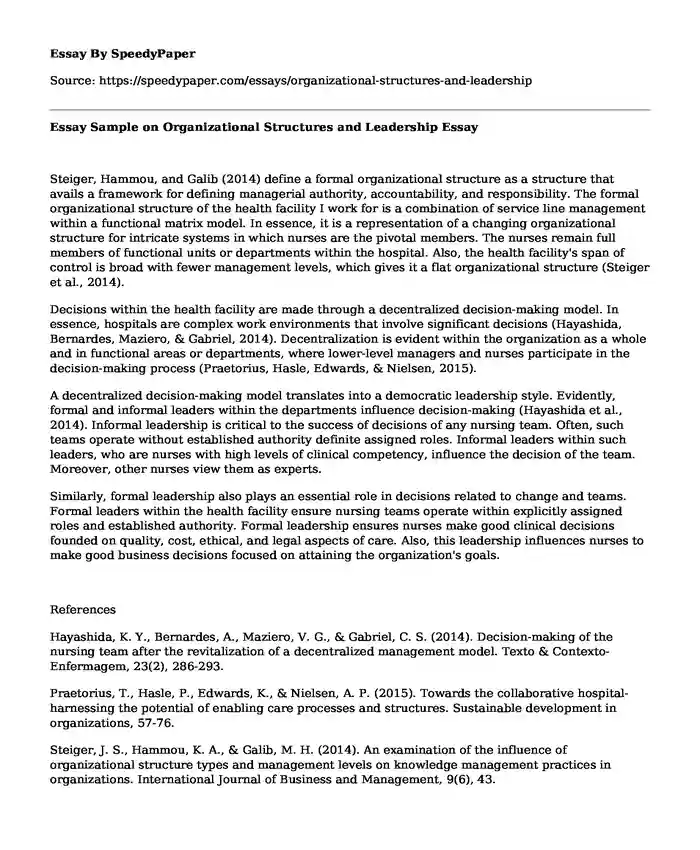
| Type of paper: | Research paper |
| Categories: | Leadership analysis Management |
| Pages: | 2 |
| Wordcount: | 393 words |
Steiger, Hammou, and Galib (2014) define a formal organizational structure as a structure that avails a framework for defining managerial authority, accountability, and responsibility. The formal organizational structure of the health facility I work for is a combination of service line management within a functional matrix model. In essence, it is a representation of a changing organizational structure for intricate systems in which nurses are the pivotal members. The nurses remain full members of functional units or departments within the hospital. Also, the health facility's span of control is broad with fewer management levels, which gives it a flat organizational structure (Steiger et al., 2014).
Decisions within the health facility are made through a decentralized decision-making model. In essence, hospitals are complex work environments that involve significant decisions (Hayashida, Bernardes, Maziero, & Gabriel, 2014). Decentralization is evident within the organization as a whole and in functional areas or departments, where lower-level managers and nurses participate in the decision-making process (Praetorius, Hasle, Edwards, & Nielsen, 2015).
A decentralized decision-making model translates into a democratic leadership style. Evidently, formal and informal leaders within the departments influence decision-making (Hayashida et al., 2014). Informal leadership is critical to the success of decisions of any nursing team. Often, such teams operate without established authority definite assigned roles. Informal leaders within such leaders, who are nurses with high levels of clinical competency, influence the decision of the team. Moreover, other nurses view them as experts.
Similarly, formal leadership also plays an essential role in decisions related to change and teams. Formal leaders within the health facility ensure nursing teams operate within explicitly assigned roles and established authority. Formal leadership ensures nurses make good clinical decisions founded on quality, cost, ethical, and legal aspects of care. Also, this leadership influences nurses to make good business decisions focused on attaining the organization's goals.
References
Hayashida, K. Y., Bernardes, A., Maziero, V. G., & Gabriel, C. S. (2014). Decision-making of the nursing team after the revitalization of a decentralized management model. Texto & Contexto-Enfermagem, 23(2), 286-293.
Praetorius, T., Hasle, P., Edwards, K., & Nielsen, A. P. (2015). Towards the collaborative hospital-harnessing the potential of enabling care processes and structures. Sustainable development in organizations, 57-76.
Steiger, J. S., Hammou, K. A., & Galib, M. H. (2014). An examination of the influence of organizational structure types and management levels on knowledge management practices in organizations. International Journal of Business and Management, 9(6), 43.
Cite this page
Essay Sample on Organizational Structures and Leadership. (2022, Jun 17). Retrieved from https://speedypaper.net/essays/organizational-structures-and-leadership
Request Removal
If you are the original author of this essay and no longer wish to have it published on the SpeedyPaper website, please click below to request its removal:
- Free Essay on The Sparrow Book
- Essay Example: Higher Interest Rates Point to More Bank Profits
- Nehru and Non-alignment - Free Essay Sample
- A Criticism of Puritan Beliefs in The Scarlet Letter, Literary Essay Sample for Students
- Research Paper on Social Demographics of India, Free Download
- Business Questions and Answers Example
- Parkison's Disease Essay Example
Popular categories




